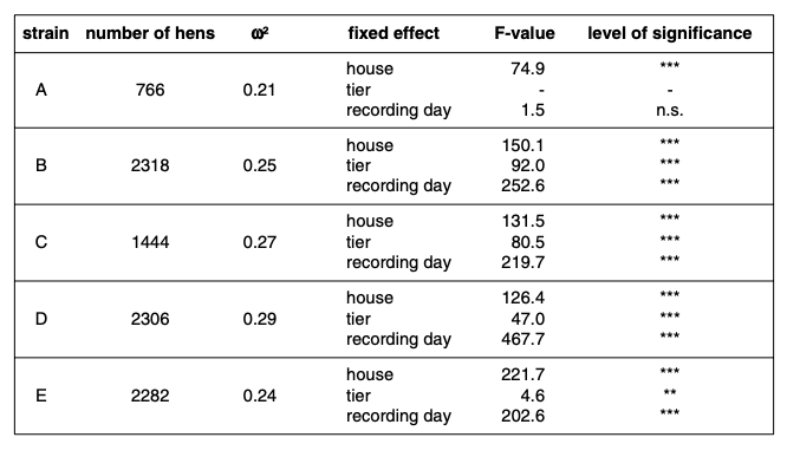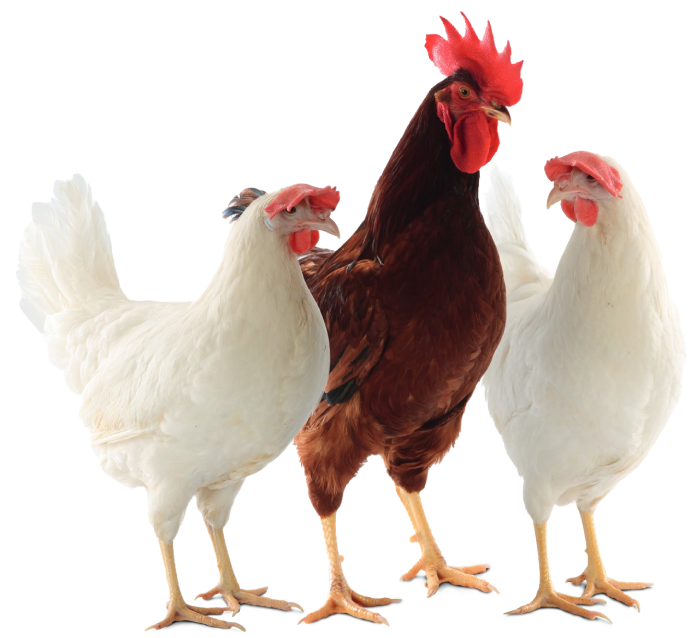Summary
The European Master in Animal Breeding and Genetics (EMABG) is a two-year MSc program provided
by six EU university groups with an active training and research program in the field of animal breeding
and genetics. The EMABG is a response to the need of highly qualified graduates in the internationally operating area of breeding farm animals and fish, and animals for other purposes. The EMABG
is recognized by the European Union as an Erasmus Mundus MSc program for a five-year period
and started in August 2007 with a group of 24 non-EU students. The students conduct the major part
of their training at two of the participating universities, and also gather for joint EMABG events.
Successful students are awarded two national masters degrees (double degree).
Successful students are awarded two national masters degrees (double degree).
Introduction
Ammonia (NH3) emission is a major concern for the poultry industry, including laying hens. KLING and QUARLES (1974), CARLILE (1984) as well as DEATON et al. (1984) showed that excessive levels of NH3 may adversely affect health and production by contributing to corneal ulcers, decreased lung function, lower egg production and reduced body weight gains. As a more general problem, it is of environmental concern as an aerial pollutant in closed houses and exhaust ammonia to the environment.In commercial cage systems, the widely used ventilation of the manure belt reduces the problematic ammonia emission effectively. The ventilation immediately dries the manure and the NH3 emission is minimized. In floor housing systems, however, ventilated manure belts are uncommon because of relatively high cost, and not possible for free-range systems. Therefore, feed specialists as ROBERTS et al. (2007) and POTTGÜTER (2008) investigated the influence of feeding fibre enhanced diets on the dry matter content of laying hen excreta and ammonia emission. The more exact method to determine moisture content applied by de Verdal et al. (2010) is not considered as practical for large numbers of hens in a commercial breeding program.
The objective of the current study was to determine whether individual differences can be determined subjectively with sufficient accuracy to serve as basis for genetic selection as a long-term approach to minimize environmental pollution. Individual observations on the consistency of the droppings of fully pedigreed hens in individual cages were collected and analyzed together with the conventional performance traits to estimate genetic parameters.
Material and methods
The weekly individually taken droppings of 9,194 White Leghorn hens of 5 LSL strains, housed in two identical single cage houses, was scored in regard to their dry matter content. A subjective score ranging from 1 (wet, < 40 % DM) to 5 (dry, > 60 % DM) was used to assess the manure of each hen in three subsequent weeks. All data were recorded by the same person, one house per day. From all hens the full pedigree is known. Performance data include egg number, daily feed intake, egg weight, shell breaking strength and body weight. During the observation period the hens’ age ranged from 41 to 46 weeks.Fixed effects as house, tier and week of observation on the individual manure score and repeatability of the manure score were estimated for each strain with the procedure MIXED of the statistics program SAS.
Model 1:
Yijklm = µ + HSi + TRj + RNk + al + eijklm
Yijklm = individual observation for each trait per record numberkl and animall
µ = overall mean
HSi = fixed effect housei
TRj = fixed effect tierj
RNkl = fixed effect record numberk
al = random effect animall
eijklm = random error
The average manure score per hen across the three observation weeks was used to study correlations with feed intake, body weight, egg production, egg weight and shell breaking strength.
Heritabilities and genetic correlations were estimated with the software package VCE 4 (GROENEVELD, 1998), using the following model 2:
Model 2:
Yijklm = µ + HSi + TRj + ak +eijkl
Yijkl = individual observation for the corresponding trait per animalk
µ = overall mean
HSi = fixed effect housei
TRj = fixed effect tierj
ak = additive genetic effect animalk
eijkl = random error
Results and Discussion
The distribution of the recorded scores was concentrated on a dry matter content between 40 % and 60 % (scores 2, 3 and 4). Extremely wet or dry manure, with a dry matter content of less than 40 % or more than 60 %, were observed on less than 5 % of the hens. In the past PREISINGER et al.(1994) measured much lower and more wide spread dry matter contents for laying hens’ manure. In his study the lowest dry matter content was on an average of 15 %, the highest with 65 % almost similar to this investigation and to results of STEFFENS et al. (2010). They published results from laboratory LUFA Nordwest obtained in 2008, where the dry matter content of laying hens’ manure varied between 38 and 66 %.
The repeatabilities for the three weekly manure scores per hen were estimated with model 1 and are shown in table 1. With the exception of strain A, the house, tier and record number had a highly significant effect on the manure score. Within these three fixed effects the highest F-value and therefore the most important effect came up to the record number in three of the five tested strains, followed by the effect house. Only 766 hens belong to strain A, which were all housed in the same tier and therefore no effect was measurable. The repeatabilities were similar for all 5 strains, ranging from ω² = 0.21 to 0.29.
Table 1: Repeatabilities (ω²) and significance of fixed effects for the manure score.

The performance traits feed intake, body weight, egg number at peak production and egg weight had a highly significant influence on the average manure score per hen. Early egg production also had a significant effect, with an error probability of p<0.01. No significant influence on the manure score could be found for shell breaking strength. The average manure score was lower for all strains in house 2, i.e. the droppings appeared wetter than in house 1. A negative trend in the dry matter content was additionally recorded from hens which were housed in the lowest tiers to the top tiers. The estimated Least-Squares-Mean score for manure consistency decreased from 3.1 to 2.8, which refer to more wet droppings in the upper than in the lower level. Differences between strains were found in this study as in a publication of LEENSTRA and PIT (1990). The analysis of variance showed that strain A had the driest, strain E the wettest manure.
The classified feed intake, body weight, egg number and egg weight also showed differences in the Least-Squares-Means for the average manure score per hen. Hens with a daily feed intake between 95g to 120g had the driest manure. A comparison of different body weight classes showed a negative relation to the average manure score. The higher the body weight, the lower the dry matter content. A desirable positive correlation was found between dryness of excreta and egg production, while larger eggs appeared to be associated with wetter manure.
With slight exceptions these described relations were confirmed by the estimated phenotypic and genetic correlations. Table 2 shows the genetic correlations between the performance traits and the manure score for each strain. Whereas the genetic correlation to the breaking strength highly varied from rg = +0.25 to rg = -0.26 between the analysed strains, the correlation to the traits feed intake, body weight, egg number at peak production and egg weight tend with exception of strain C always in the same direction. Therefore, the estimated genetic correlations not only confirm the results of the previous variance analysis, but also the conclusions of a study of LEENSTRA et al. (1992). Hens with dryer manure eat less feed, have a lower body weight, lay more eggs, especially at peak production and their eggs are smaller. Together with heritabilities that are in accordance to table 2 on a medium level for the manure score (h² = 0.14 to h² = 0.36), it is possible to consider the texture of manure in a selection program for layers.
Table 2: Heritabilities for manure score and conventional traits and their genetic correlations
to manure score per strain.

Conclusion
Measuring the actual individual dry matter content of the droppings of large numbers of hens is not technically feasible in commercial breeding programs. Instead, subjective scoring of the dryness of weekly droppings from birds housed in single bird cages was investigated as an indicator trait for water content in the manure for individual hens. Estimated heritabilities in the range of 14 to 36 % for this trait suggest enough genetic variation within lines to expect response from selection, which would be a contribution to more environment friendly egg production. Hens with the desired performance profile, i.e. producing more eggs from less feed, apparently tend to produce drier excreta.With the addition of subjective scored manure-consistency in the selection index a significant sustainable contribution to a more environmental friendly egg production can be achieved.Zusammenfassung
Kotkonsistenz als Selektionskriterium in der Legehennenzucht Eine subjektive Kotbeurteilung von Leghennen in Einzelkäfigen ist als Merkmal zur Bestimmung des Wassergehaltes in Exkrementen geeignet. Die exakte Berechnung des tierspezifischen Trockensubstanzgehaltes im Legehennenkot ist hingegen zu aufwendig, um die Kotkonsistenz in ein Zuchtprogramm zu etablieren. Für die subjektive Beurteilungsnote des Kotes wurden Heritabilitäten von 14 bis 36 % geschätzt. Diese versprechen genügend genetische Varianz innerhalb der Linien, für eine erfolgreiche Selektion auf den Trockensubstanzgehalt im Hühnerkot. Wünschenswerte genetische Korrelationen zu weiteren wichtigen Selektionsmerkmalen, wie der Futteraufnahme und der Eizahl, sowie ein relativ geringer Aufwand für die Datenerfassung unterstützen die Einbeziehung dieses Merkmals in den Selektionsindex. Die subjektive Kotbeurteilung liefert einen nachhaltigen Beitrag zu einer umweltfreundlicheren Eierproduktion.Reference
DE VERDAL, H. et al. (2010): Selection for excreta traits in chicken. Proc. 9th World Congress on Genetics Applied to Livestock Production, Leipzig, Germany, 183.CARLILE, F.S. (1984): Ammonia in poultry houses: A literature review. World’s Poultry Sci. Jour. 40:99-113.
DEATON, J.W., F.N. REECE, and B.D. LOTT (1984): Effect of atmospheric ammonia on laying hen performance. Poultry Science 63:384-385.
HARTINI, S., M. CHOCT, G. HINCH and J. NOLAN (2003): Australian Egg Corporation Limit, April 2003.
KLING, H.F. and C.L. QUARLES (1974): Effect of atmospheric ammonia and the stress of infectious bronchitis vaccination on leghorn males. Poultry Sci. 53:1161-1167.
LEENSTRA, F.R. and R. PIT (1990): Strain differences in water content of droppings of laying hens. Proc. VIIIth European Poultry Conference, Barcelona, Spain,.435-437.
LEENSTRA, F.R., D.K. FLOCK, A.J. van den BERG and R. PIT (1992): Inheritance of water content and drying characteristics of droppings of laying hens. Proc. 19th World’s Poultry Congress, Amsterdam, Netherlands, 201-204.
POTTGÜTER, R. (2008): Fiber in layer diets. Lohmann Information, 43 (2), 22-31.
PREISINGER, R., D.K. FLOCK and F.R. LEENSTRA (1994): Reduction of environmental pollution by breeding tools in a commercial layer program. Proceedings of the 5th World Congress on Genetics Applied to Livestock Production, Guelph, Ontario, Canada, 49-52.
ROBERTS, S.A., H. XIN, B.J. KERR, J.R. RUSSELL and K. BREGENDAHL (2007): Effects of dietary fiber and reduced crude protein on ammonia emission from laying-hen manure. Poultry Science 86:1625-1632.
STEFFENS, G., P. HILLER, O. BOHNENKEMPER (2010): Nährstoffgehalte Hühnertrockenkot, neue Faustzahlen. www.lwk-niedersachsen.de/…/340,5ec95199-237d-eebf-5ecf922d5a3c0cbe~pdf.html






